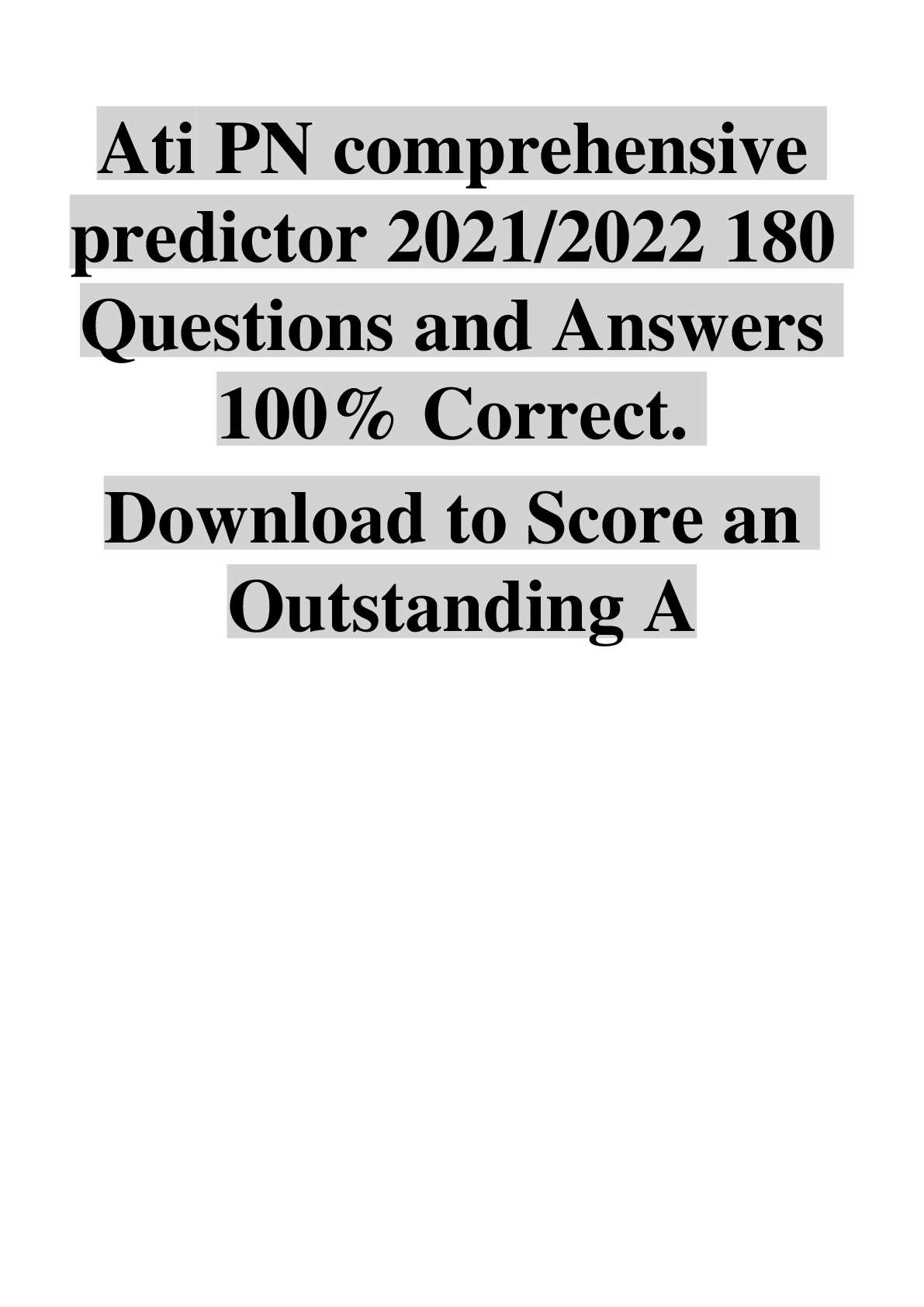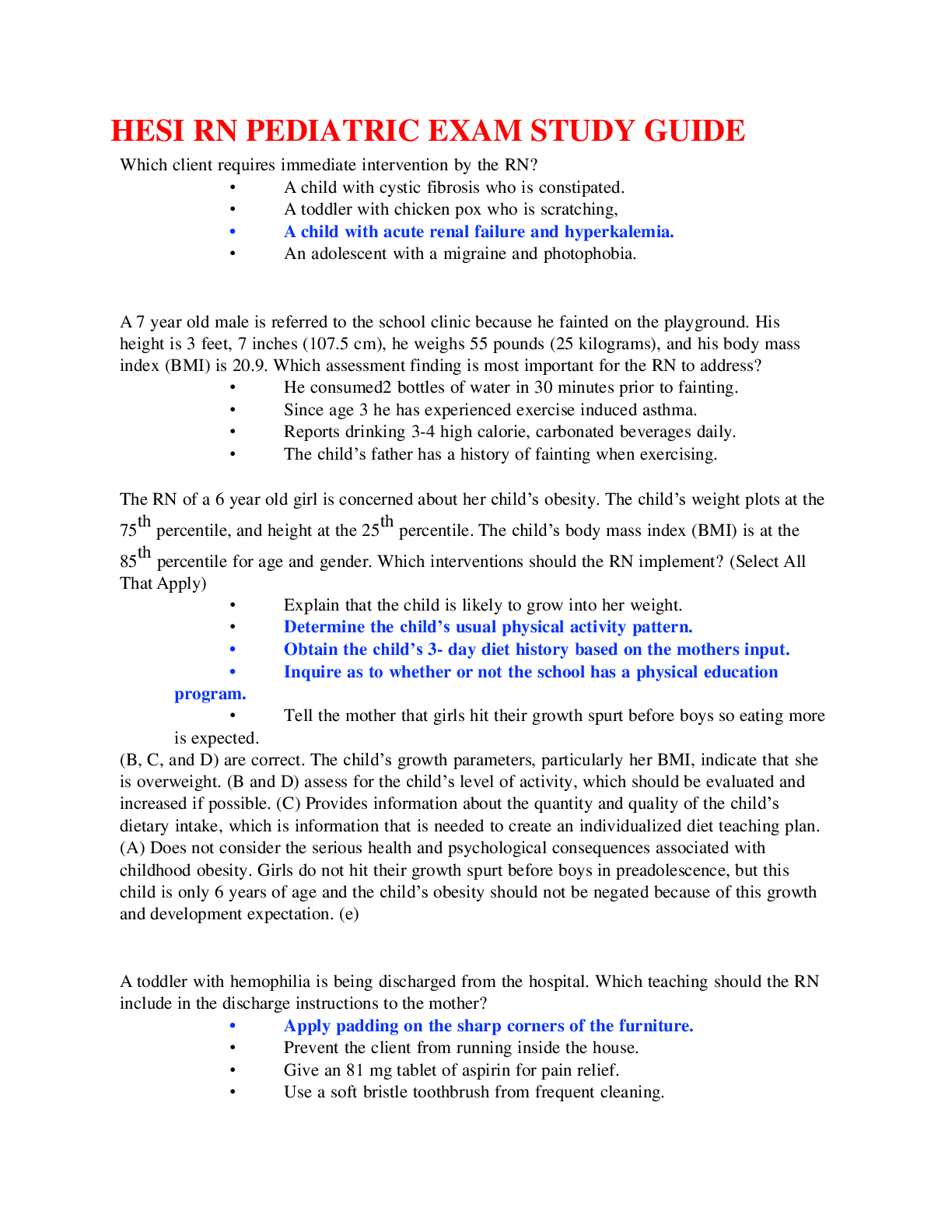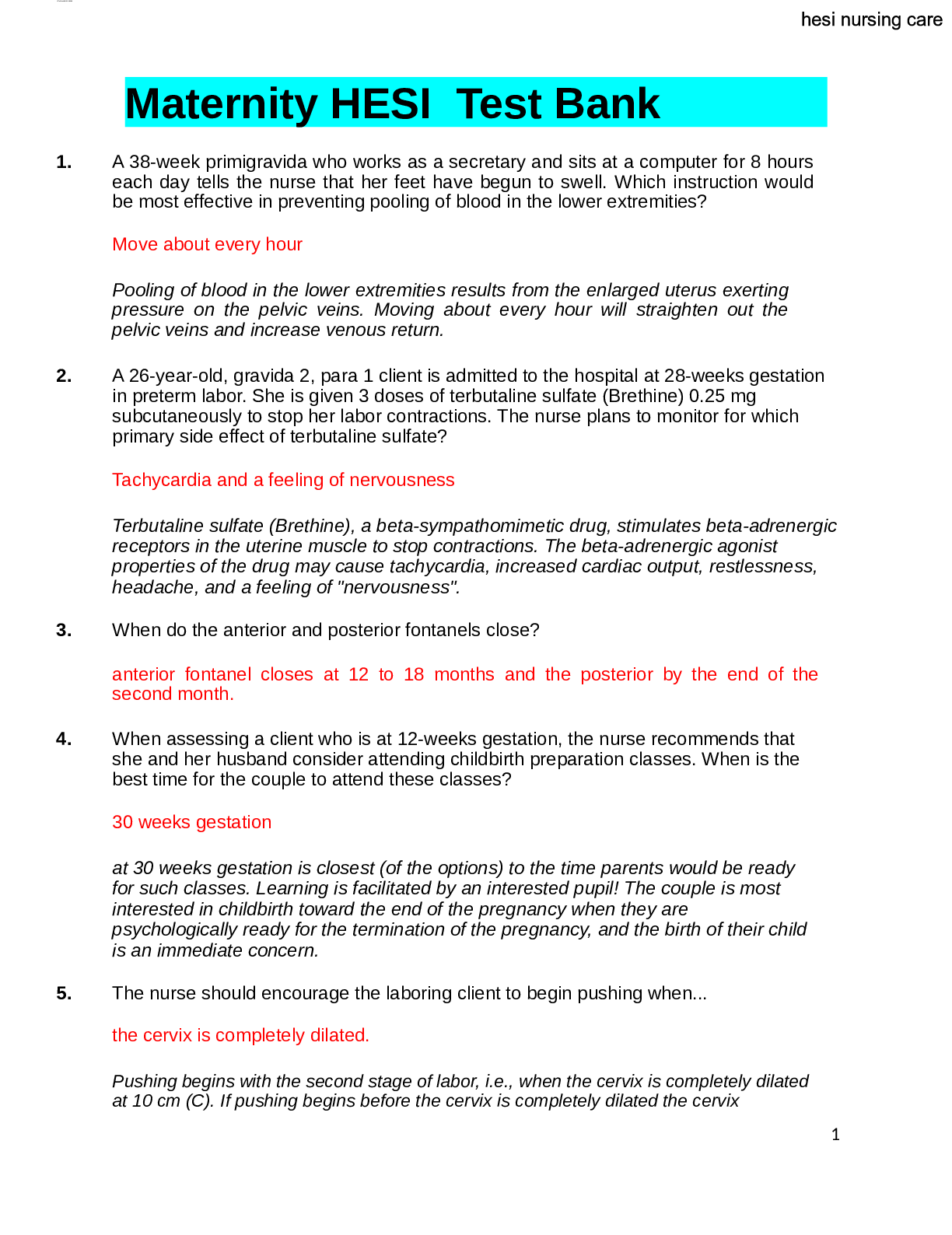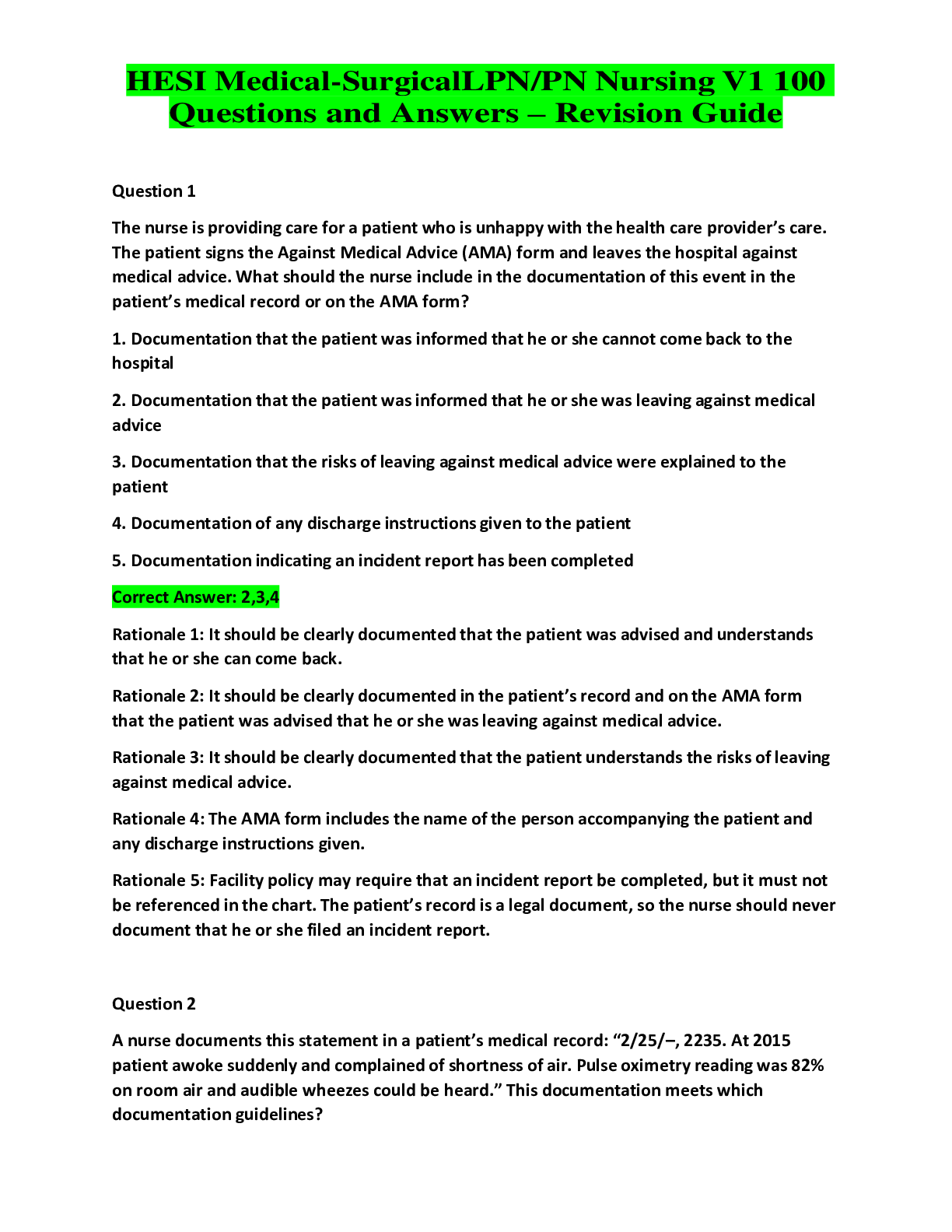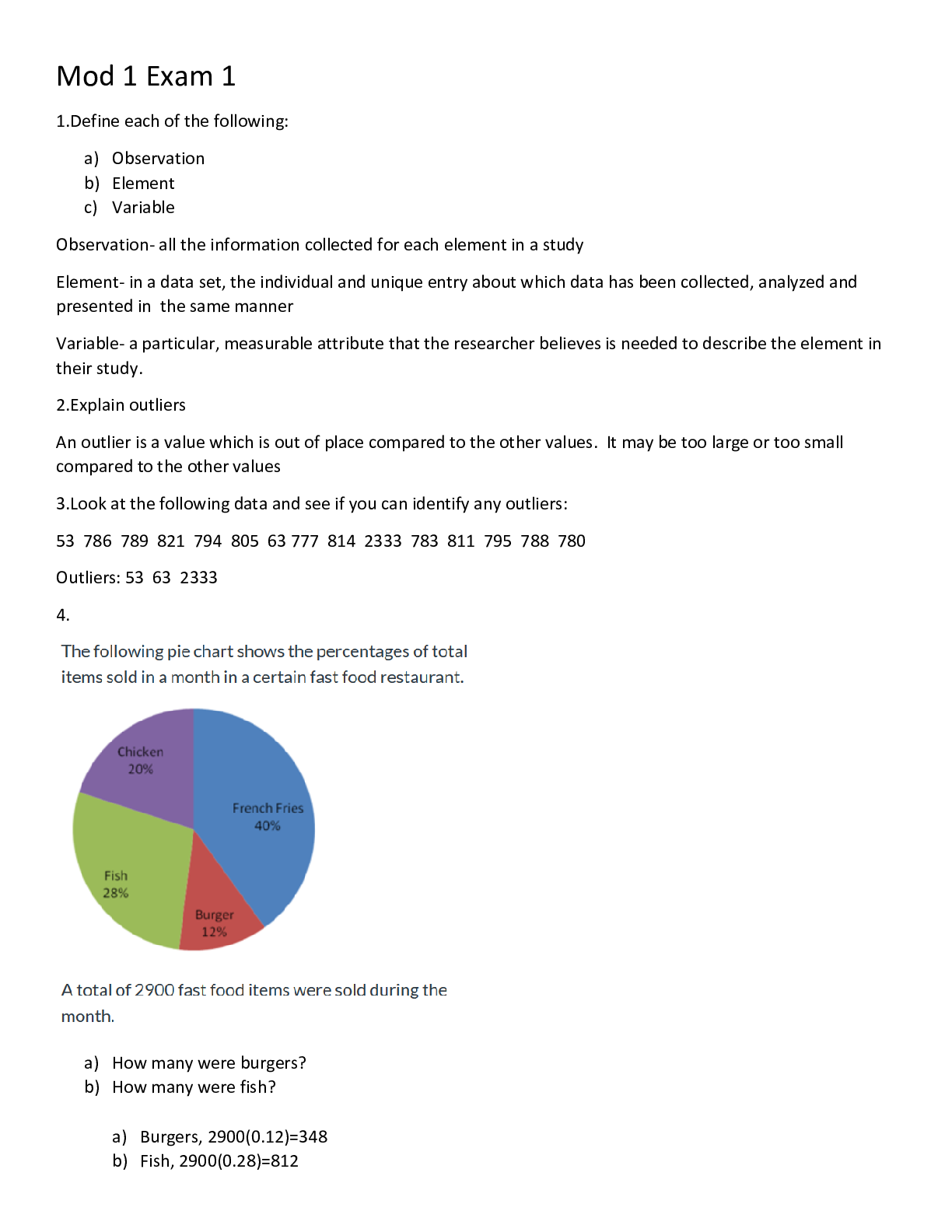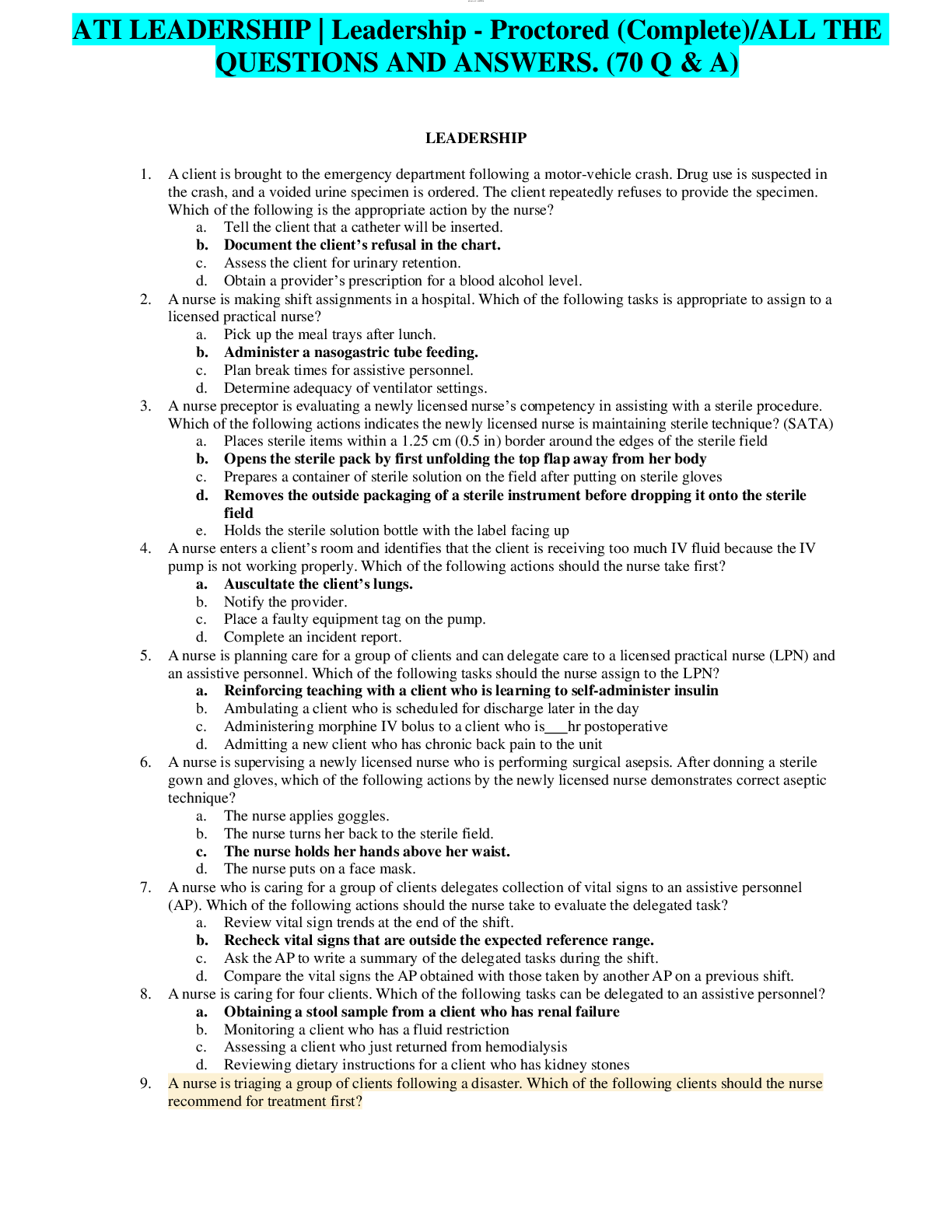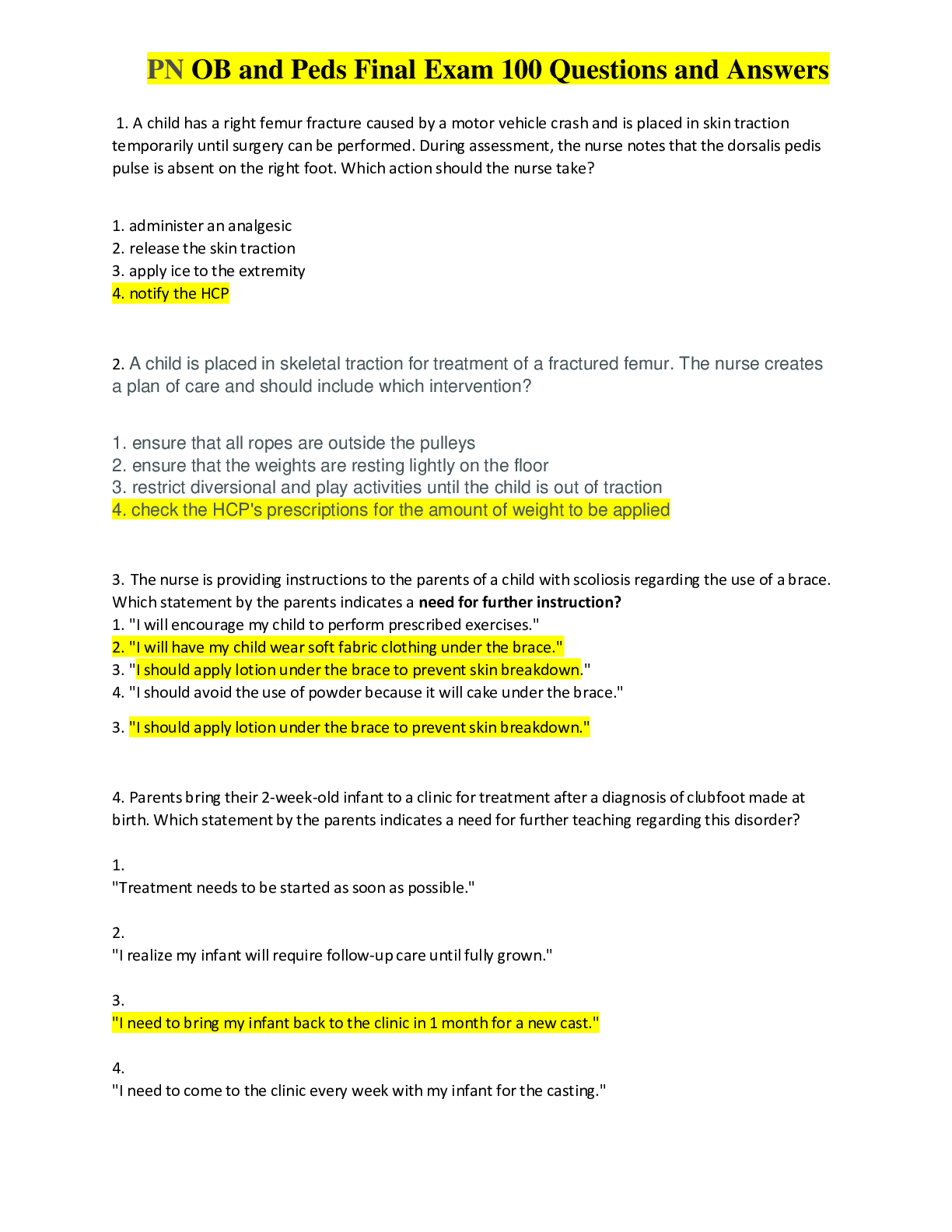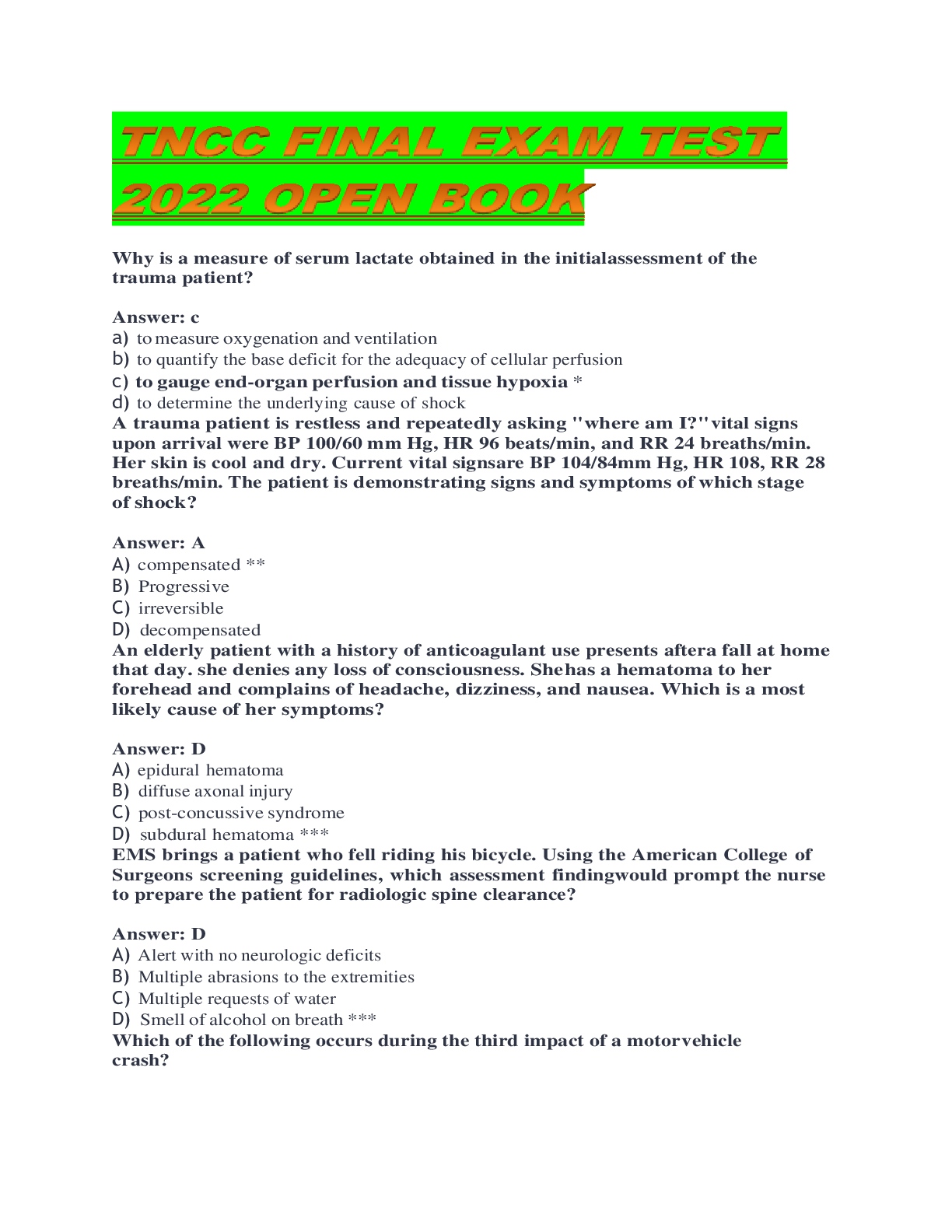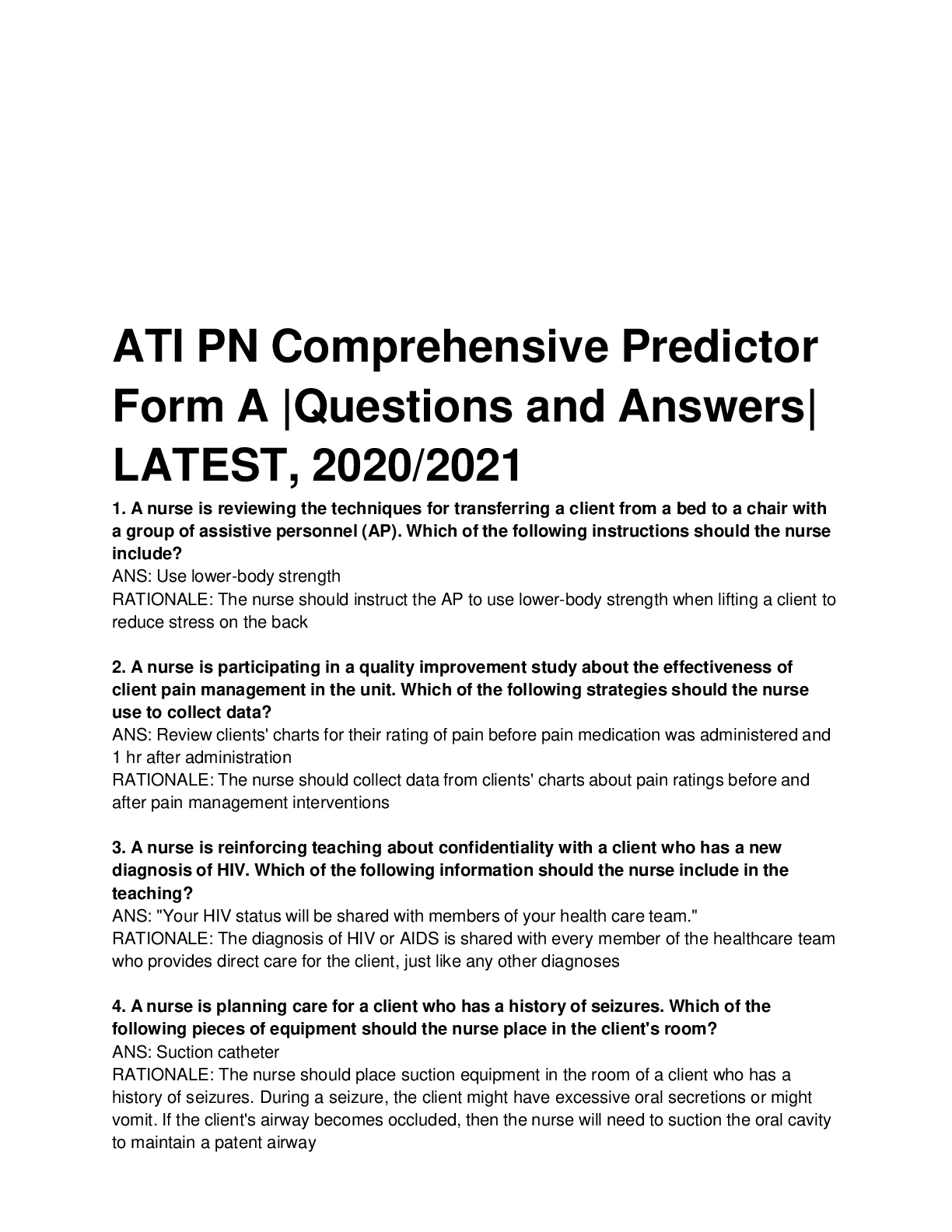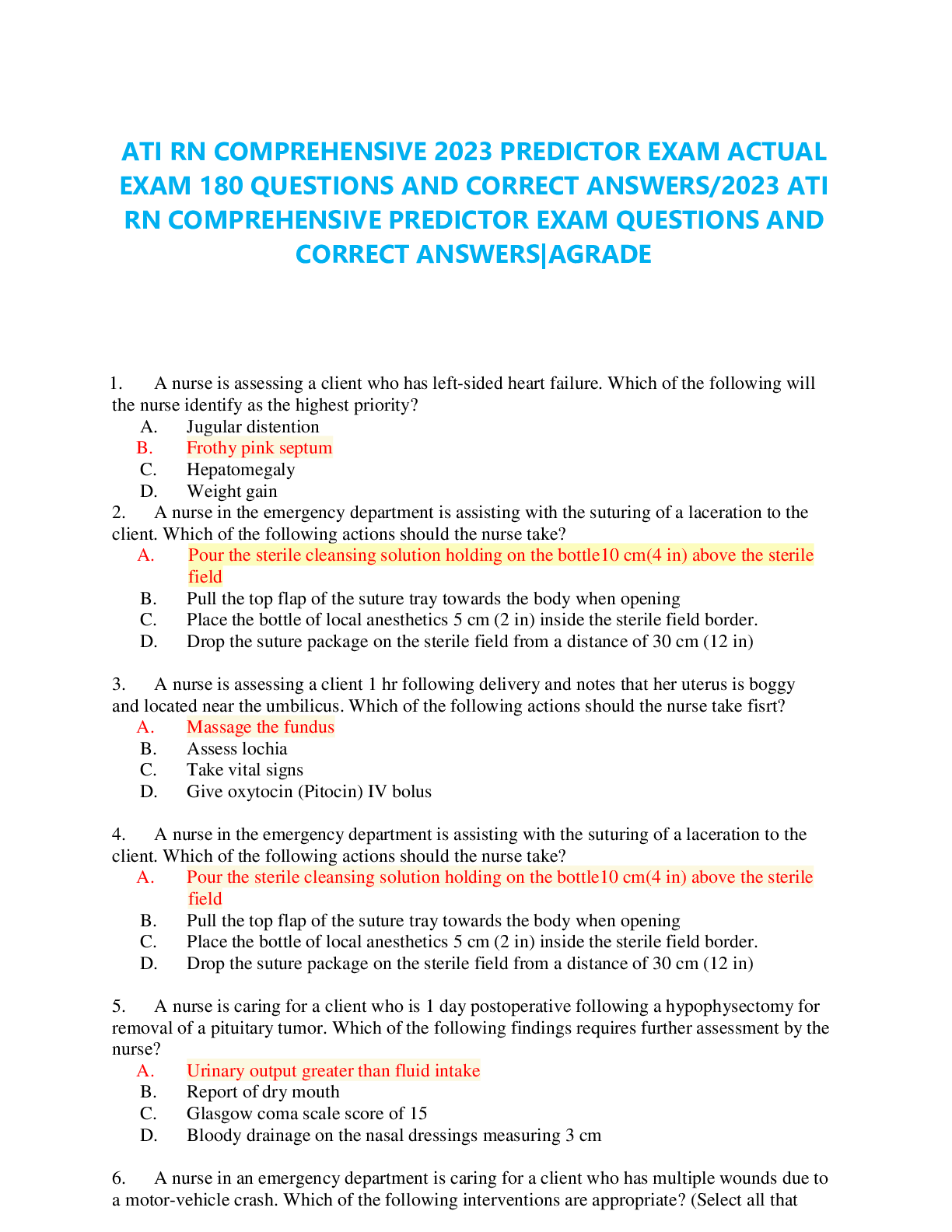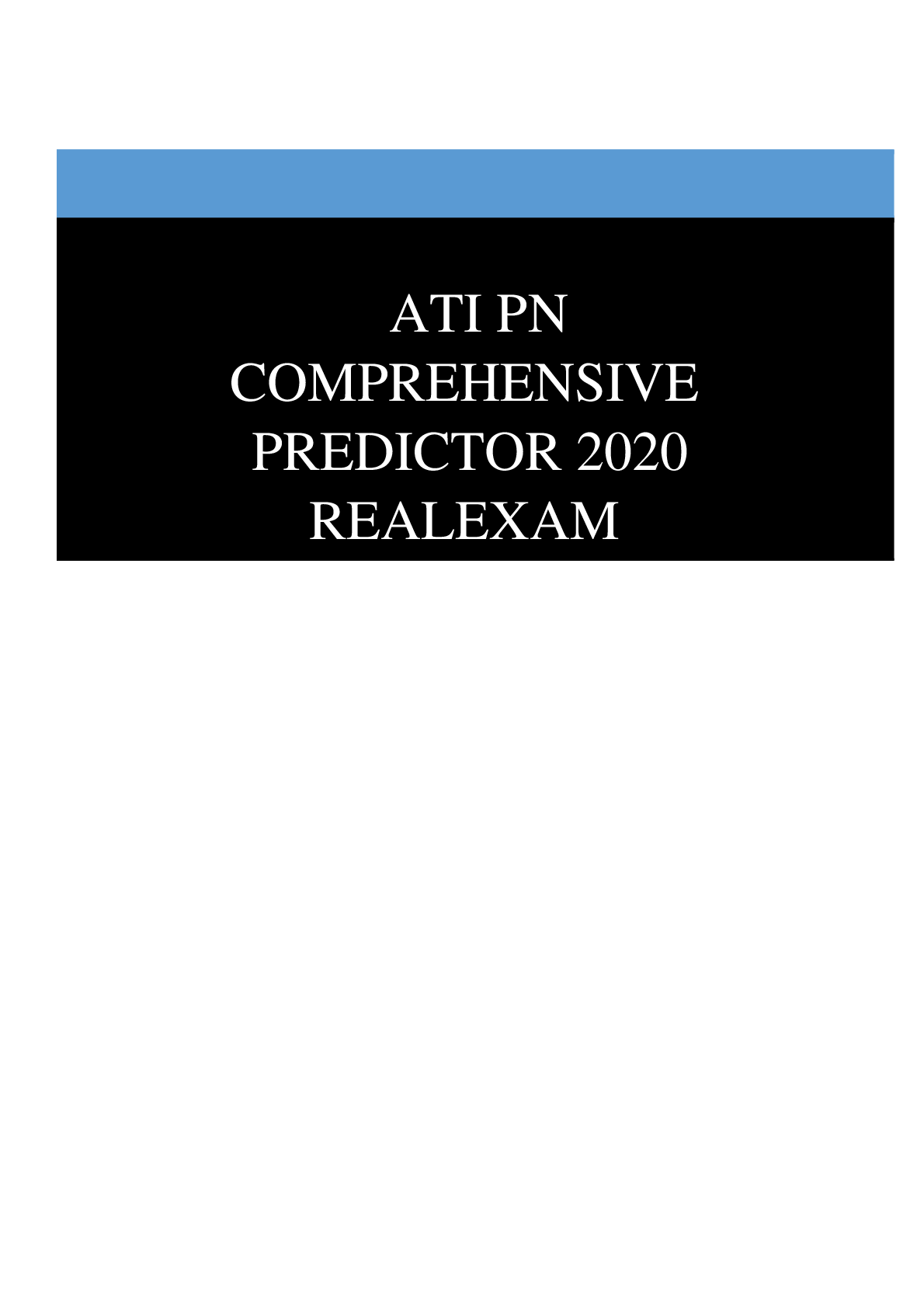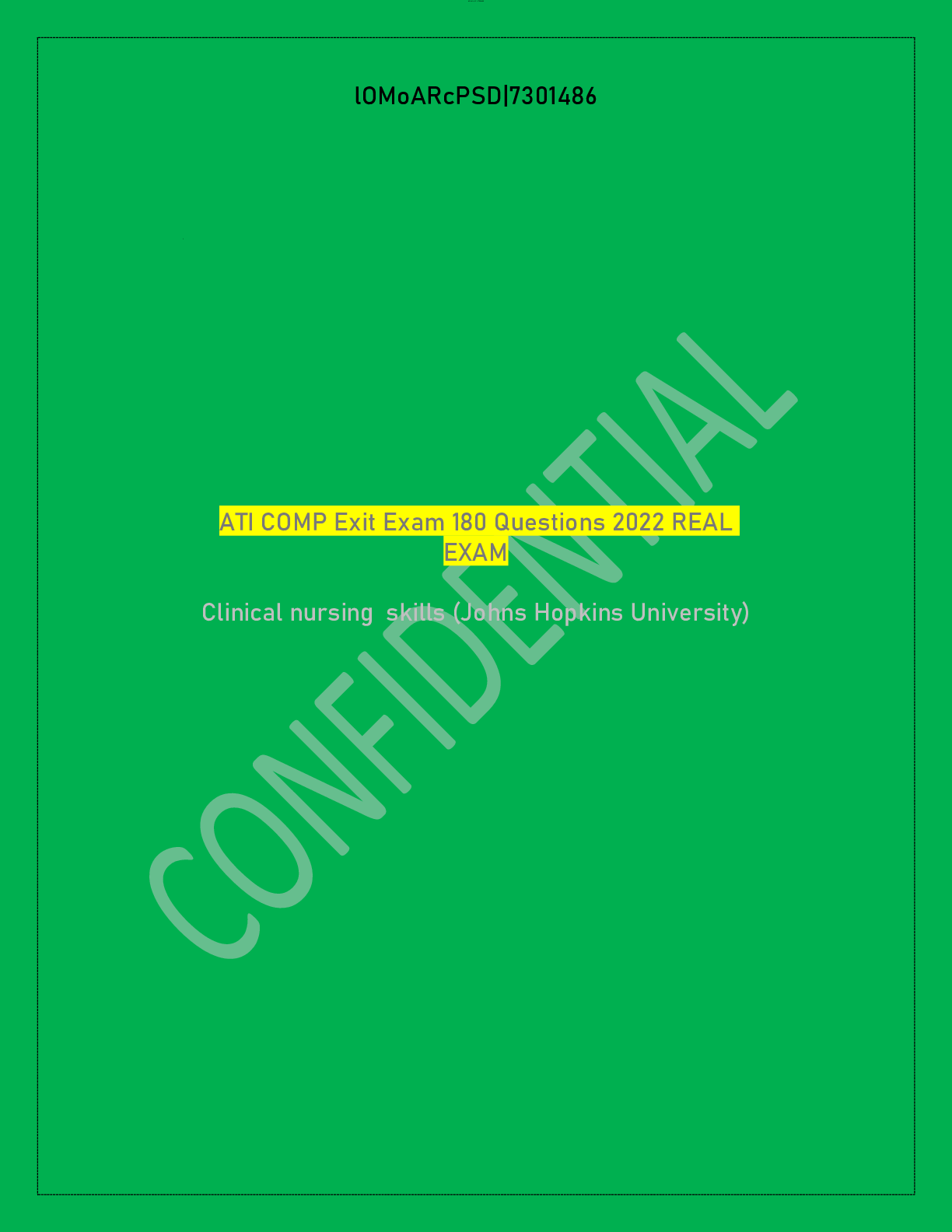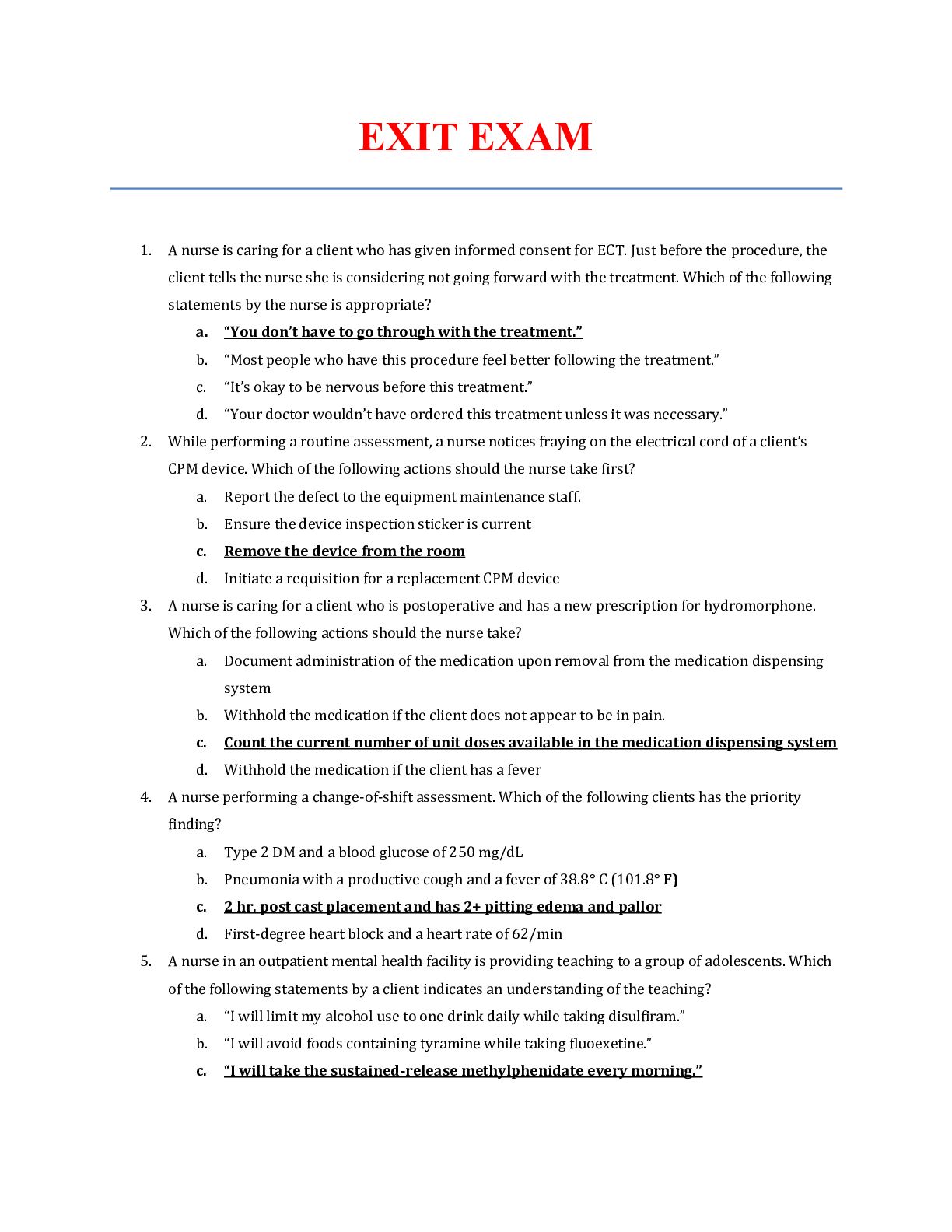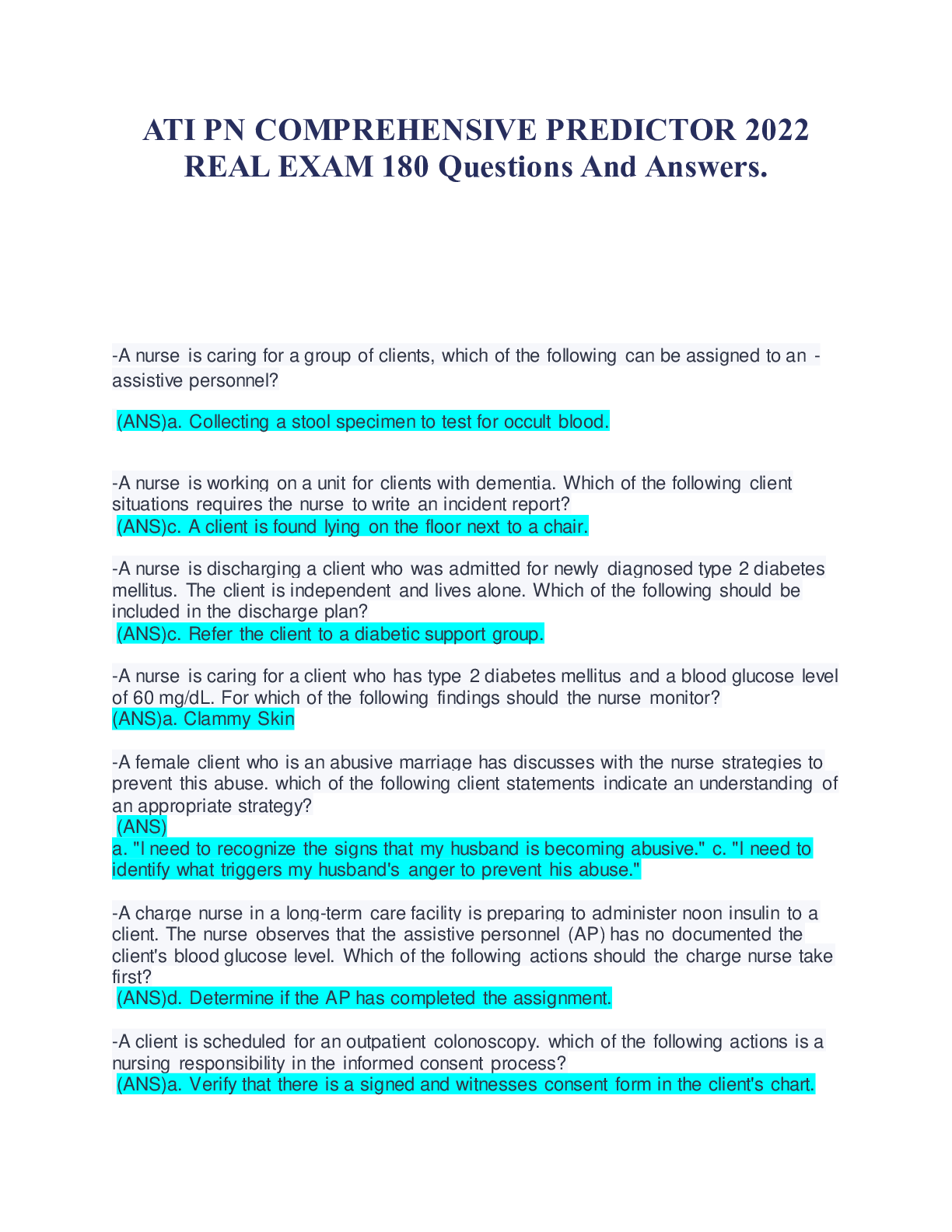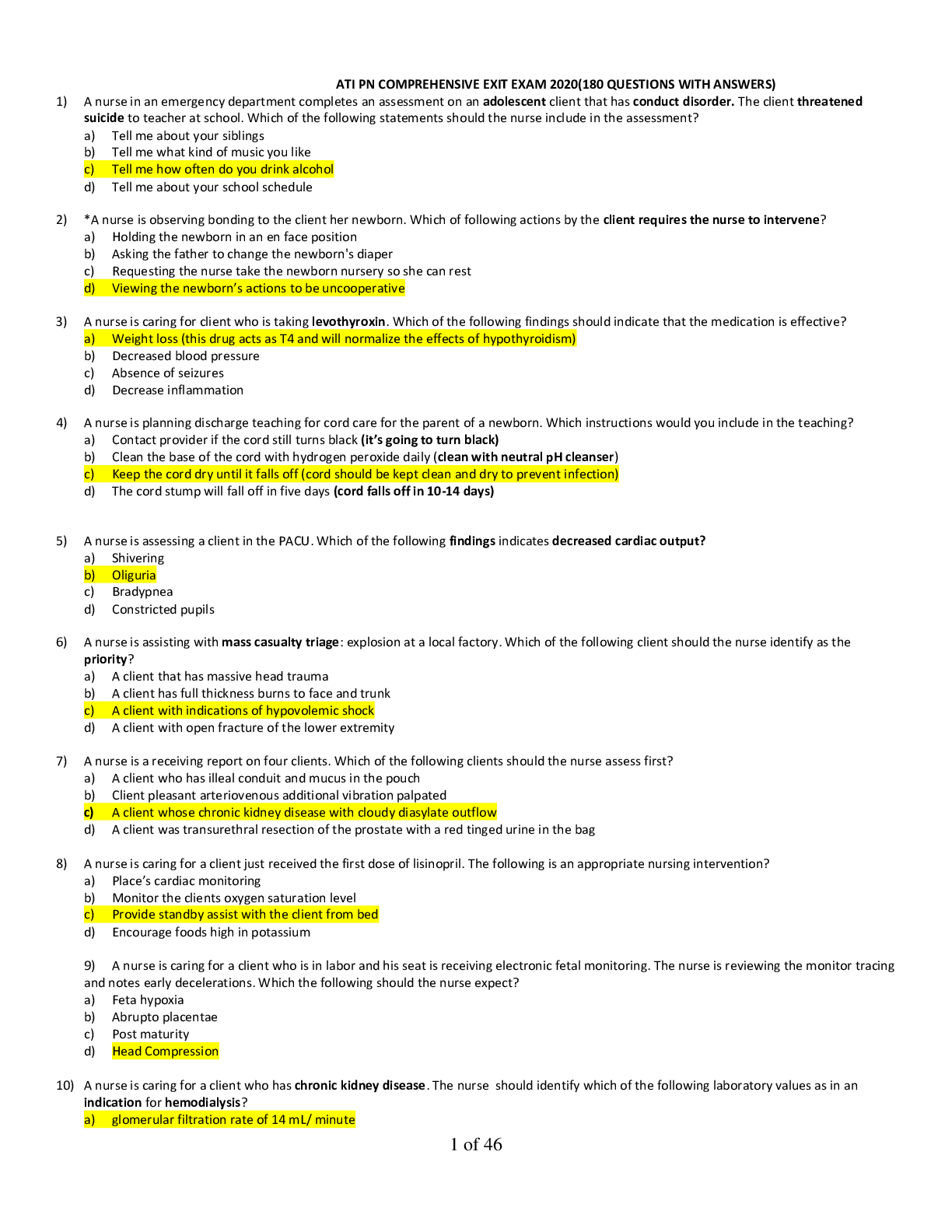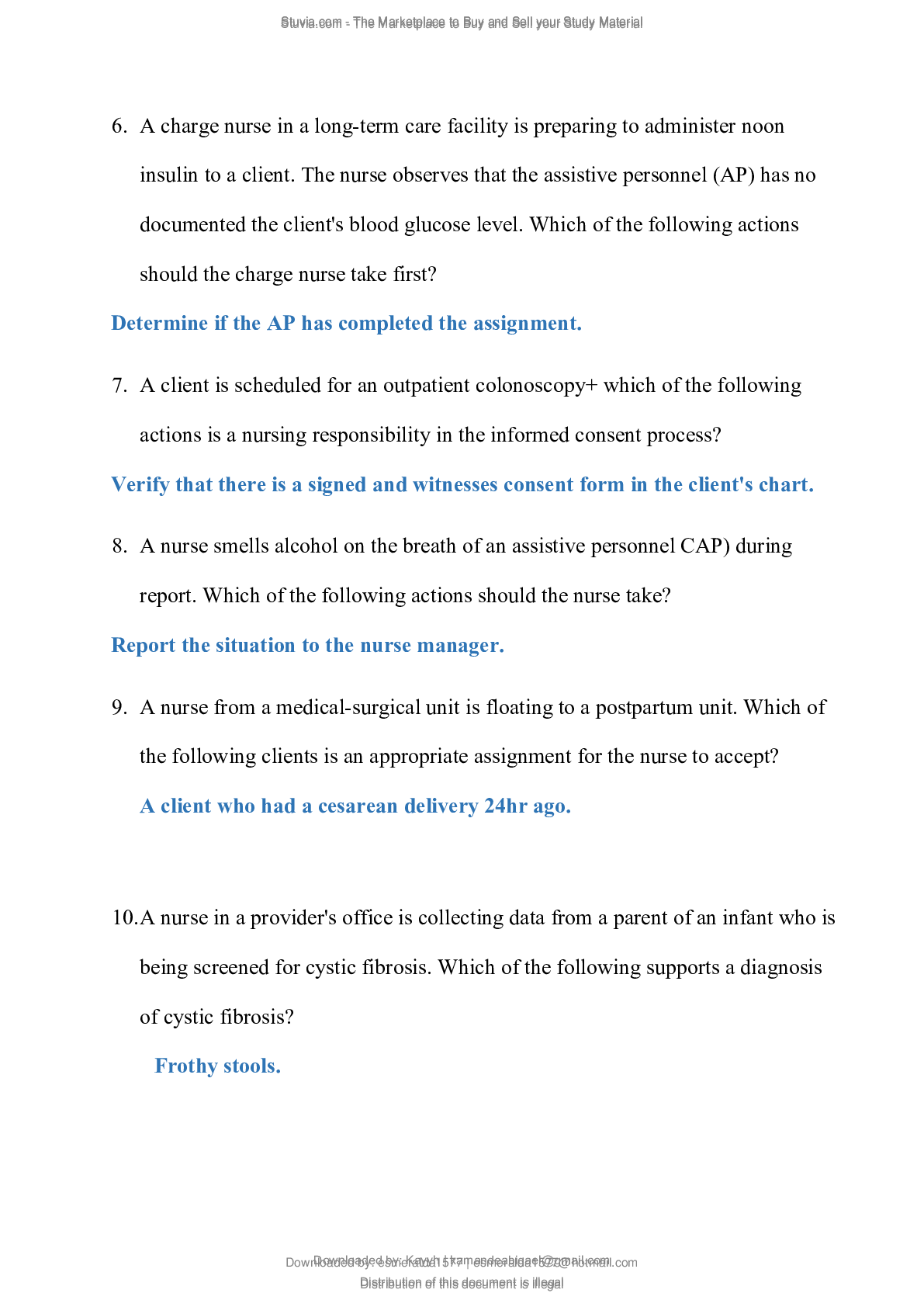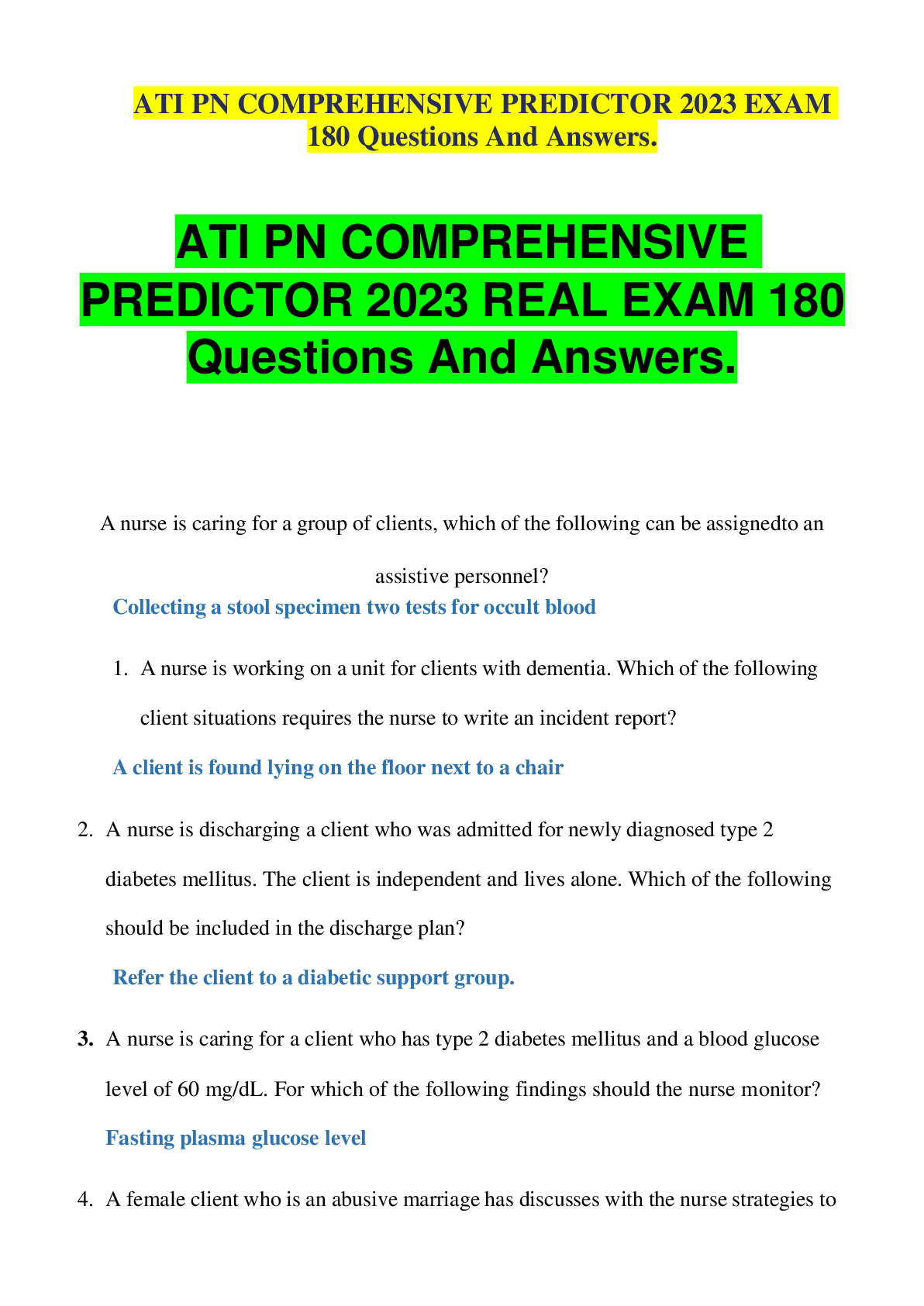HESI EXIT EXAM 180 QUESTIONS AND ANSWERS 2021/2022, (100% CORRECT)
Document Content and Description Below
HESI EXIT EXAM QUESTIONS AND ANSWERS 2021/2022, (100% CORRECT) 1. A nurse is reviewing the laboratory results of a client who has rheumatoid arthritis. Which of the following findings should the nurs... e report to the provider? A. WBC count 8,000/mm3. B. Platelets 150,000/mm3. C. Aspartate aminotransferase 10 units/L. d. Erythrocyte sedimentation rate 75 mm/hr 2. A nurse is caring for a client who has generalized petechiae and ecchymoses. The nurse should expect a prescription for which of the following laboratory tests? A. Platelet count. B. Potassium level. C. Creatine clearance. D. Prealbumin. 3. A nurse is caring for a client following application of a cast. Which of the following actions should the nurse take first? A. Place an ice pack over the cast. B. Palpate the pulse distal to the cast. C. Teach the client to keep the cast clean and dry. D. Position the casted extremity on a pillow. 4. A nurse is caring for a client who has vision loss. Which of the following actions should the nurse take? (Select all that apply) A. Keep objects in the client’s room in the same place. B. Ensure there is high-wattage lighting in the client’s room. C . Approach the client from the side. D. Allow extra time for the client to perform tasks. E . Touch the client gently to announce presence. 5. A nurse is caring for a client who is newly diagnosed with pancreatic cancer and has questions about the disease. To research the nurse should identify that which of the following electronic database has the most comprehensive collection of nursing (Unable to read) articles? A. MEDLINE B. C INAHL. C. ProQuest. D. Health Source. 6. A nurse in an emergency department is assessing newly admitted client who is experiencing drooling and hoarseness following a burn injury. Which of the following should actions should the nurse take first? A. Obtain a baseline ECG. B. Obtain a blood specimen for ABG analysis. C. Insert an 18-gauge IV catheter. D. Administer 100% humidified oxygen. 7. A nurse is planning care for a client who has unilateral paralysis and dysphagia following a right hemispheric stroke. Which of the following interventions should the nurse include in the plan? A. Place food on the left side of the client’s mouth when he is ready to eat. B. Provide total care in performing the client’s ADLs. C. Maintain the client on bed rest. D. Place the client’s left arm on a pillow while he is sitting. 8. A nurse is caring for a client who is in a seclusion room following violent behavior. The client continues to display aggressive behavior. Which of the following actions should the nurse take? A. . Confront the client about this behavior. B. Express sympathy for the client’s situation. C. Speak assertively to the client. D. Stand within 30 cm (1 ft) of the client when speaking with them. 9. A nurse is caring for a client who is receiving brachytherapy for treatment of prostate cancer. Which of the following actions should the nurse take? A. Cleanse equipment before removal from the client’s room. B. Limit the client’s visitors to 30 min per day. C. Discard the client’s linens in a double bag. D. Discard the radioactive source in a biohazard bag 10. A nurse is caring for a client who has severe preeclampsia and is receiving magnesium sulfate intravenously. The nurse discontinues the magnesium sulfate after the client displaces toxicity. Which of the following actions should the nurse take? a. Position the client supine b. Prepare an IV bolus of dextrose 5% in water c. Administer methylergonovine IM d. Administer calcium gluconate IV 11. A charge nurse is teaching new staff members about factors that increase a client’s risk to become violent. Which of the following risk factors should the nurse include as the best predictor of future violence? a. Experiencing delusions b. Male gender d. A history of being in prison 12. A nurse is preparing to perform a sterile dressing change. Which of the following actions should the nurse take when setting up the sterile field? a. Place the cap from the solution sterile side up on clean surface b. Open the outermost flap of the sterile kit toward the body→ flap AWAY from the body's first c. Place the sterile dressing within 1.25 cm (0.5in) of the edge of the sterile field → 2.5 cm (1-inch) border around any sterile drape or wrap that is considered contaminated. d. Set up the sterile field 5 cm (2 in) below waist level→ it says BELOW waist level; should be ABOVE waist level 13. A nurse is providing teaching to an older adult client about methods to promote nighttime sleep. Which of the following instructions should the nurse include? a. Eat a light snack before bedtime b. Stay in bed at least 1 hr if unable to fall asleep c. Take a 1 hr nap during the day d. Perform exercises prior to bedtime 14. A home health nurse is preparing for an initial visit with an older adult client who lives alone. Which of the following actions should the nurse take first? a. Educate the client about current medical diagnosis b. Refer the client to a meal delivery program c. Identify environmental hazards in the home d. Arrange for client transportation to follow-up appointments Rationale Priority: Assess first. 15. A nurse is assessing the remote memory of an older adult client who has mild dementia. Which of the following questions should the nurse ask the client? a. “Can you tell me who visited you today?” b. “What high school did you graduate from c. “Can you list your current medications?” d. “What did you have for breakfast yesterday?” 16. A nurse is providing teaching to an adolescent who has type 1 diabetes mellitus. Which of the following goals should the nurse include in the teaching a. HbA1c level greater than 8%- 6.5 - 8 is the target reference. > b. Blood glucose level greater than 200 mg/dL at bedtime c. Blood glucose level less than 60 mg/dL before breakfast- < 70 = HYPOGLYCEMIC d. HbA1c level less than 7% 17. A nurse is caring for a client who is receiving phenytoin for management of grand mal seizures and has a new prescription for isoniazid and rifampin. Which of the following should the nurse conclude if the client develops ataxia and incoordination? a. The client is experiencing an adverse reaction to rifampin b. The client’s seizure disorder is no longer under control c. The client is showing evidence of phenytoin toxicity c. The client is having adverse effects due to combination antimicrobial therapy 18. A nurse is caring for a client who is 1 hr postoperative following rhinoplasty. Which of the following manifestations requires immediate action by the nurse? a. Increase in frequency of swallowing→ may indicate bleeding b. Moderate sanguineous drainage on the drip pad c. Bruising to the face→ side effect d. Absent gag reflex→ possibly due to anesthesia given. (1 hour postoperative) Rationale “Requires immediate action” choose the worst possibility that could lead to. ABC 19. A nurse is planning care for a preschool-age child who is in the acute phase Kawasaki disease. Which of the following interventions should the nurse include in the plan of care? a. Give scheduled doses of acetaminophen every 6 hr b. Monitor the child’s cardiac status c. Administer antibiotics via intermittent IV bolus for 24 hr d. Provide stimulation with children of the same age in the playroom 20. A nurse is planning an educational program for high school students about cigarette smoking. Which of the following potential consequences of smoking is most likely to discourage adolescents from using tobacco? a. Use of tobacco might lead to alcohol and drug abuse b. Smoking in adolescence increases the risk of developing lung cancer later in life c. Use of tobacco decreases the level of athletic ability d. Smoking in adolescence increases the risk of lifelong addiction A nurse is assessing a client who is prescribed spironolactone. Which of the following laboratory values should the nurse monitor for this client? a. Total bilirubin b. Urine ketones c. Serum potassium- diuretic that retains potassium= hyperkalemic risk d. Platelet count 21. A nurse has agreed to serve as an interpreter for an older adult client who is assigned to another nurse. Which of the following statements by the nurse indicates an understanding of this role? a. “I will let the client know that I am available as the interpreter.” b. “I will receive a small fee for interpreting for this client.” c. “I am glad I’m available today, but when I’m not, you can use a family member.” d. “I will let the client know that an interpreter is unavailable during the night shift.” 22. A nurse in a pediatric unit is preparing to insert an IV catheter for 7-year- old. Which of the following actions should the nurse take? a. (Unable to read) b. Tell the child they will feel discomfort during the catheter insertion. c. Use a mummy restraint to hold the child during the catheter insertion. d. Require the parents to leave the room during the procedure. 23. A nurse is caring for a client who has arteriovenous fistula which of the following findings should the nurse report? a. Thrill upon palpation. b. Absence of a bruit. c. Distended blood vessels d. Swishing sound upon auscultation. 24. A nurse is providing discharge teaching for a client who has an implantable cardioverter defibrillator which of the following statements demonstrates understanding of the teaching? a. “I will soak in the tub rather and showering” b. “I will wear loose clothing around my ICD” c. “I will stop using my microwave oven at home because of my ICD” d. “I can hold my cellphone on the same side of my body as the ICD” 25. A nurse is caring for a client who is at 14 weeks gestation and reports feelings of ambivalence about being pregnant. Which of the following responses should the nurse make? a. “Describe your feelings to me about being pregnant” b. “You should discuss your feelings about being pregnant with your provider” c. “Have you discussed these feelings with your partner?” d. “When did you start having these feelings?” 26. A nurse is planning care for a client who has a prescription for a bowel- training program following a spinal cord injury. Which of the following actions should the nurse include in the plan of care? a. Encourage a maximum fluid intake of 1,500 ml per day. b. Increase the amount of refined grains in the client’s diet. c. Provide the client with a cold drink prior to defecation. d. Administer a rectal suppository 30 minutes prior to scheduled defecation times. 27. A nurse is performing physical therapy for a client who has Parkinson’s disease. Which of the following statements by the client indicates the need for a referral to physical therapy? A. “I have been experiencing more tremors in my left arm than before” B. “I noticed that I am having a harder time holding on to my toothbrush” C. “ Lately, I feel like my feet are freezing up, as they are stuck to the ground” D. “Sometimes, I feel I am making a chewing motion when I’m not eating” 28. A nurse is reviewing laboratory data for a client who has chronic kidney disease. Which of the following findings should the nurse expect? A. Increased creatine. B. Increased hemoglobin. C. Increased bicarbonate. D. Increased calcium. 29. A nurse is administering a scheduled medication to a client. The client reports that the medication appears different than what they take at home. Which of the following responses should the nurse take? A. “Did the doctor discuss with you that there was a change in this medication?” B. “I recommend that you take this medication as prescribed” C. “Do you know why this medication is being prescribed to you?” D. “ I will call the pharmacist now to check on this medication” 30. A charge nurse is recommending postpartum client discharge following a local disaster. Which of the following should the nurse recommend for discharge? A. A 42-year-old client who has preeclampsia and a BP of 166/110 mm Hg. B. A 15-year-old client who delivered via emergency cesarean birth 1 day ago. C. A client who received 2 units of packed RBCs 6 hr. ago for a postpartum hemorrhage. D. A client who delivered precipitously 36 hr. ago and has a second-degree perineal laceration. 31. A nurse in a provider’s office is reviewing the laboratory results of a group of clients. Which to report? a. Herpes simplex. b. Human papillomavirus c. Candidiasis d. Chlamydia 32. A nurse is providing discharge teaching for a group of clients. The nurse should recommend a referral to a dietitian A. A client who has a prescription for warfarin and states “I will need to limit how much spinach I eat”. B. A client who has gout and states, “I can continue to eat anchovies on my pizza.” C. A client who has a prescription for spironolactone and states “I will reduce my intake of foods that contain potassium”. D. A client who has (Unable to read) and states “I’ll plan to take my calcium carbonate with a full glass of water”. 33. A nurse is preparing to measure a temperature of an infant. Which of the following action should the nurse take? A . Place the tip of the thermometer under the center of the infant’s axilla. B . Pull the pinna of the infant’s ear forward before inserting the probe. B. Insert the probe 3.8 cm (1.5in) into the infant’s rectum. C. Insert the thermometer in front of the infant’s tongue. 34. A nurse in a pediatric clinic is teaching a newly hired nurse about the varicella rooster. Which of the following information should the nurse include? A. . Children who have varicella are contagious until vesicles are crusted. B. . Children who have varicella should receive the herpes zoster vaccination. C . Children who have varicella should be placed in droplet precaution. D. Children who have varicella are contagious 4 days before the first vesicle eruption. 35. A nurse is reviewing the laboratory report of a client who has been having lithium carbonate for the past 12 months. The nurse notes a lithium level of 0.8 mEq/L. Which of the following orders from the provider should the nurse expect? A. Withhold the next dose. B. Increase the dosage. C. Discontinue the medication. D. Administer the medication. 36. A nurse is caring for a client who has fibromyalgia and requests pain medication. Which of the following medications should the nurse administer? A. Pregabalin B. Lorazepam C.Colchicin D. Codeine. 37. A nurse is caring for a client who is to receive a transfusion of packed RBCs. Which of the following actions should the nurse take? A . Prime IV tubing with 0.9% sodium chloride. B. Use a 24-gauge IV catheter C. Obtain filter less IV tubing. D. Place blood in the warmer for 1 hr. 38. A nurse is caring for a toddler who has acute lymphocytic leukemia. In which of the following should the toddler participate? A. Looking at alphabet flashcards. B. P laying with a large plastic truck. C. Use scissors cut out paper shapes. D. Watching a cartoon in the dayroom. 39. A nurse is caring for a client who has chronic pancreatitis. Which of the following dietary recommendations should the nurse make? A. Coffee with creamer. B. Lettuce with sliced avocados. C. B roiled skinless chicken breast with brown rice. D. Warm toast with margarine. 40. A nurse is caring for a client who is in active labor and requests pain management. Which of the following actions should the nurse take? a. Administer ondansetron. b. Place the client in a warm shower. c. Apply fundal pressure during contractions. d. Assist the client to a supine position. 41. A nurse in an emergency department is performing triage for multiple clients following a disaster in the community. To which of the following types of injuries should the nurse assign the highest priority? a. Below-the knee amputation b. Fractured tibia c. 95% full-thickness body burn d. 10cm (4in) laceration to the forearm 42. A nurse manager is updating protocols for the use of belt restraints. Which of the following guidelines should the nurse include? a. Remove the client’s restraint every 4hr b. Document the client’s condition every 15 min c. Attach the restrain to the bed’s side rails d. Request a PRN restrain prescription for clients who are aggressive 43. A nurse is teaching an in-service about nursing leadership. Which of the following information should the nurse include about an effective leader? a. Acts as an advocate for the nursing unit. b. (Unable to read) for the unit c. Priorities staff request over client needs. d. Provides routine client care and documentation. 44. A nurse is reviewing the laboratory findings of a client who has diabetes mellitus and reports that she has been following her (unable to read) care. The nurse should identify which of the following findings indicates a need to revise the client’s plan of care. a. Serum sodium 144 mEq/ b. (Unable to read) c. Hba1c 10 % d. Random serum glucose 190 mg/dl. 45. A nurse is caring for a client who is at 38 weeks of gestation and has a history of hepatitis C. The client asks the nurse if she will be able to breastfeed. Which of the following responses by the nurse is appropriate? b. You must use a breast pump to provide breast milk. c. You must use nipple shield when breastfeeding. d. You may breastfeed after your baby develops his antibiotics. 46. A nurse is caring for a client who has returned to the medical-surgical unit following a transurethral resection of the prostate. Which of the following should the nurse identify as priority nursing assessment after reviewing the clients information? Exhibit. d. Bowel sounds 47. A nurse is caring for a client who has hyperthermia. Which of the following actions for the nurse to take? a. Submerge the adolescent feet in ice water b. Cover the adolescent with a thermal blanket → if hypothermia. c. Administer oral acetaminophen 48. A nurse manager is updating protocols for belt restraints. Which of the following guidelines should the nurse include? c. Request a PRN restraints prescription for clients who are aggressive d. Remove the client restraints every 4 hours 49. A nurse in emergency department is caring for a client who has full thickness burn of the thorax and upper torso. After securing the client's airway, which of the following is the nurse's priority intervention? a. Providing pain management b. Offering emotional support c. Preventing infection 50. A nurse is caring for a client who has cancer and is being transferred to hospice care. The client’s daughter tells the nurse, “I’m not sure what to say to my mom if she asks me about dying.” which of the following responses by the nurse is appropriate? (SATA) A. H [Show More]
Last updated: 1 year ago
Preview 1 out of 44 pages
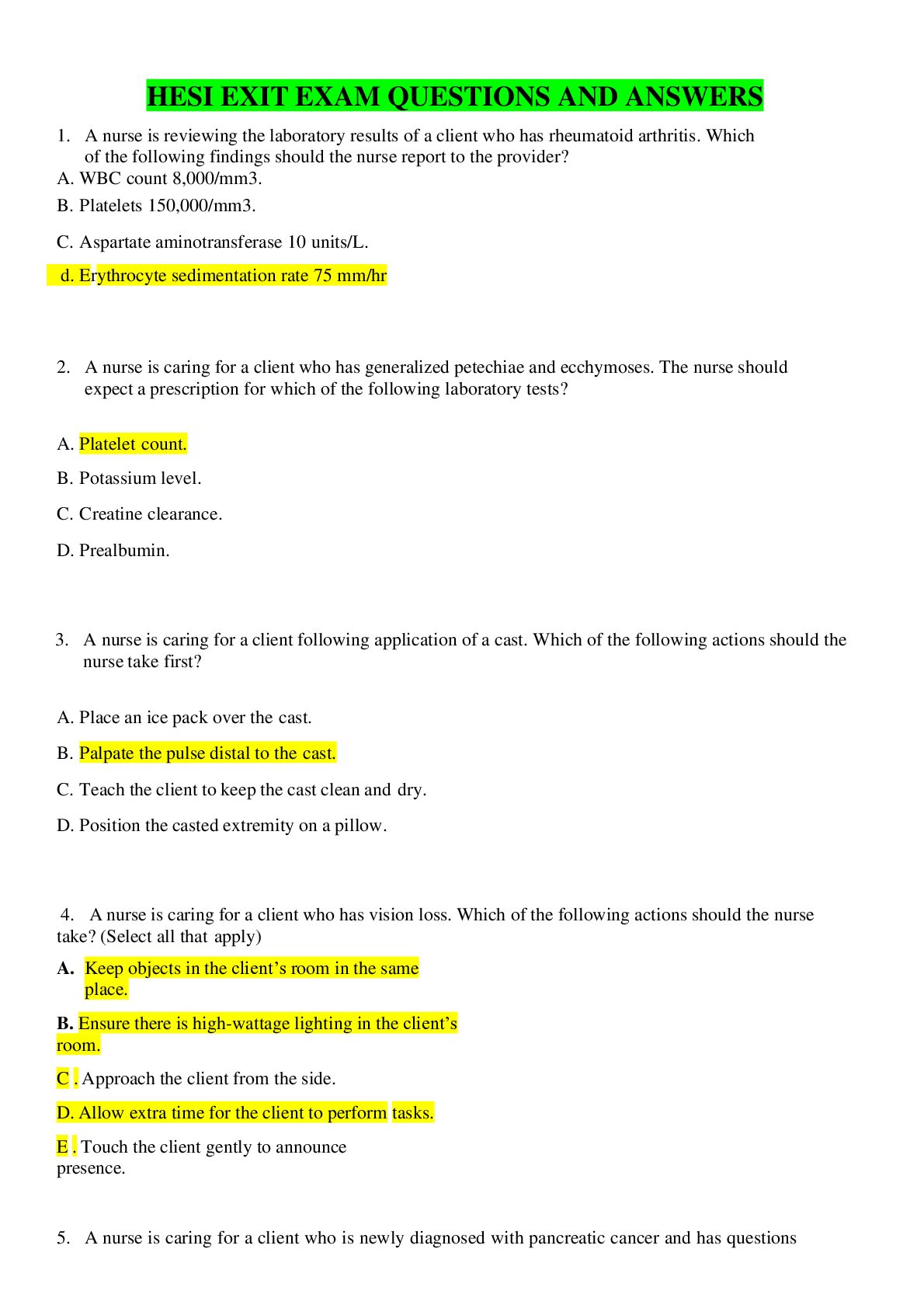
Also available in bundle (1)
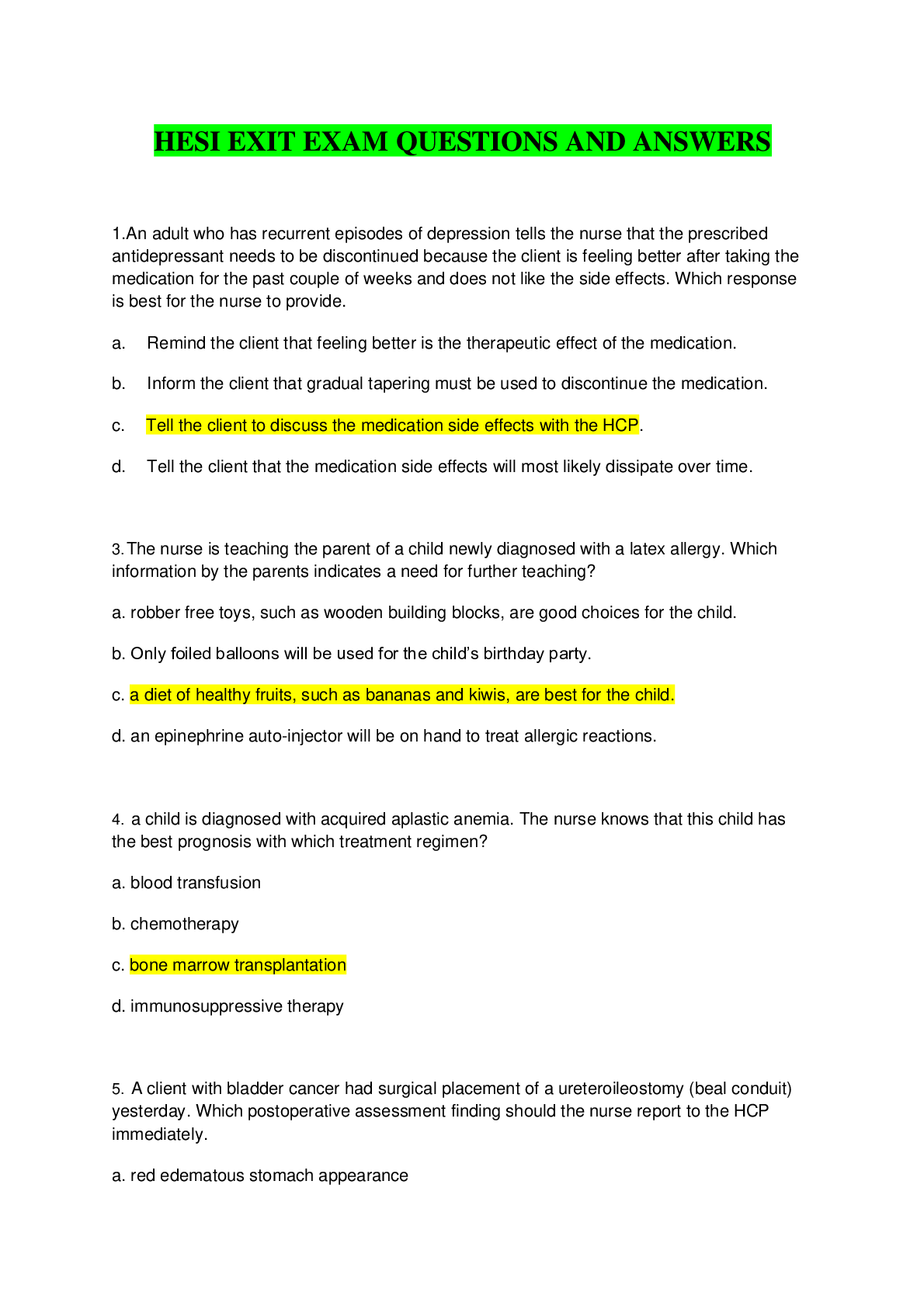
HESI EXIT EXAMS QUESTIONS AND ANSWERS 2022 - Study Guide
HESI EXIT EXAMS QUESTIONS AND ANSWERS 2022 - Study Guide
By PHISHER 1 year ago
$25
3
Reviews( 0 )
Document information
Connected school, study & course
About the document
Uploaded On
Jul 21, 2022
Number of pages
44
Written in
Additional information
This document has been written for:
Uploaded
Jul 21, 2022
Downloads
0
Views
72

